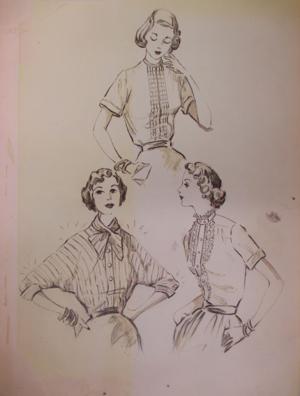Fashion from the 1950s and Hager Department store at Lancasterhistory
Newspaper ads used to be filled with enticing illustrations that drew their women readers toward the latest fashions.
From elegant ball gowns to sprightly culottes, the magical pen of the fashion illustrators captured each fold and pleat in perfect poses with the aim of popularizing new styles.
Around the middle of the last century, Helen Rutter Cruess worked as an artist at Lancaster's Hager Department Store at West King and Market streets.
An exhibit of her advertising art, titled “Fashion From the ’50s: The Artwork of Helen Rutter Cruess,” opens Saturday at the Stoudt Gallery at LancasterHistory.
Her illustrations show women in light dresses with bouquets of flowers and wide-brimmed portrait hats. They wear delicate lingerie and lacy wedding gowns. They pose in stylish shorts and sleeveless summer dresses with sunglasses. They wear plush fur coats, cozy A-line cloth coats and jaunty, full-skirted plaid dresses. There are sexy back views, with deep-cut draped bows and high-heeled pumps.
"Helen Cruess was very stylish herself, a true beauty, who dressed very well," says Lynn Kreiser Miller, who is donating her collection of some 150 pieces of Cruess' work to the museum.
kissybridesmaid blue bridesmaid dresses
Miller rescued some of it from a Reading antiques dealer, who almost sent it to the dumpster before he realized its value.
Another local collector of Cruess’ work, Paul Montigny, had more than 200 of Cruess’ drawings. They were combined with Miller's and donated to the museum — making more than 350 in all.
Fine and commercial artist
"I was fortunate to meet Helen later in her life. She was a lovely woman, very pleasant and quiet," Montigny recalls. "I think she would have felt honored with this exhibit."
Born in 1897 in Philadelphia, Cruess was the daughter of Bertha Connell Cruess and architect and watercolorist Francis Howse Cruess, who designed Lancaster Theological Seminary.
A talented fine artist, Cruess studied at the Art Students League of New York with sculptor Alexander Calder, creating works such as "Niija," which was shown in the Ridgewood Art Exhibit in New Jersey along with drawings by her father. She was a graduate of the New York School of Applied Design for Women.
In New York City, Cruess did window displays for the Staples-Smith store and illustrated books. When her father's health began to fail, she moved to Lancaster, where he was living on Charlotte Street.
Job was ‘outsourced’
Cruess found her niche in Lancaster's art world when she joined Hager’s Department Store staff. Her lively figures are perfectly coifed and dressed in the latest fashions.
At the time, artists used a type of art board known as CraftTint. Since ad reproduction was in black and white, the art board allowed for shadows and shading that would reproduce in the newspaper.
"These are outstanding examples of advertising art from the time," says Barry Rauhauser, Stauffer curator and director of History on the Web at LancasterHistory. "We are pleased that Lynn and Paul have donated this fabulous collection."
As Rauhauser notes, the illustrations are a reflection of the fashions of the times, when women were expected to have impossibly small waists accented by full skirts and long graceful legs in high heels.
Sadly, Cruess' career with Hager ended when her job was outsourced to an ad agency in 1959 and mats replaced the art board.
As Montigny notes, "She must have felt bad about that. Now people will know how talented she was."
The collection also includes several illustrations for a book of Hans Christian Anderson fairy tales, such as "The Little Mermaid," and other book illustrations.
gold bridesmaid dresses